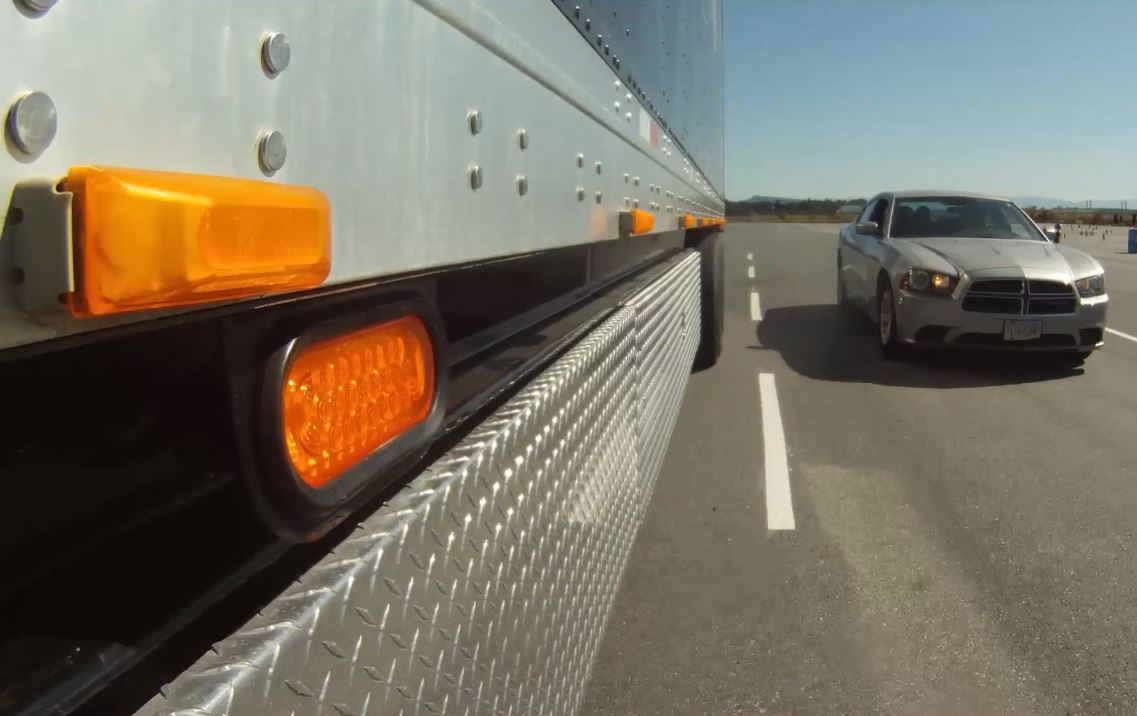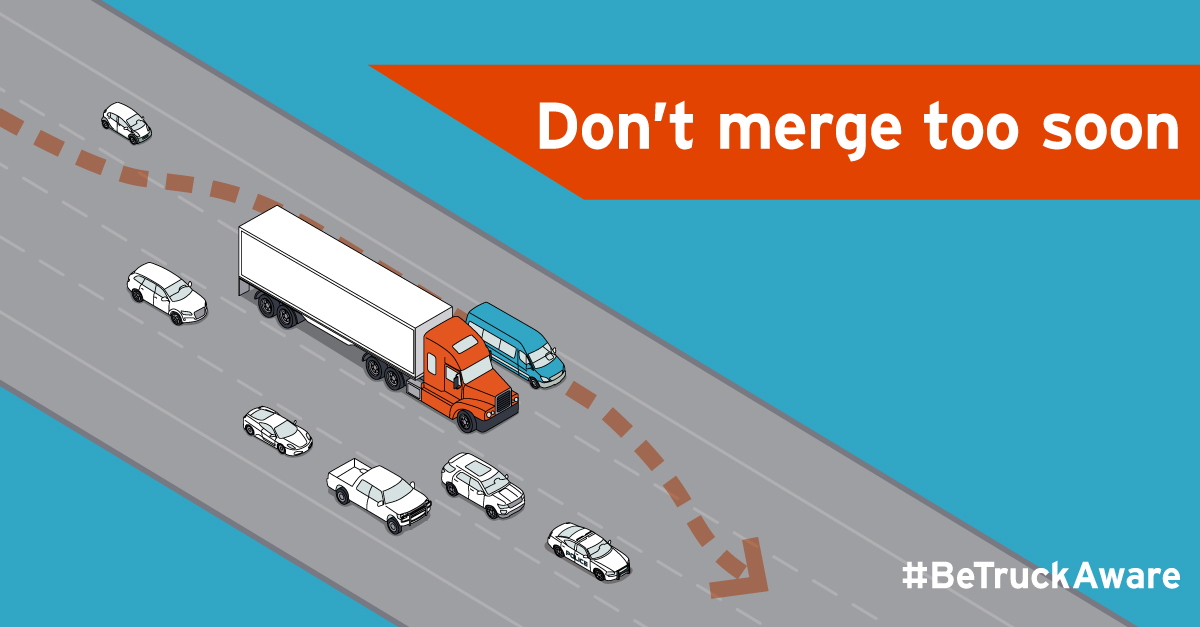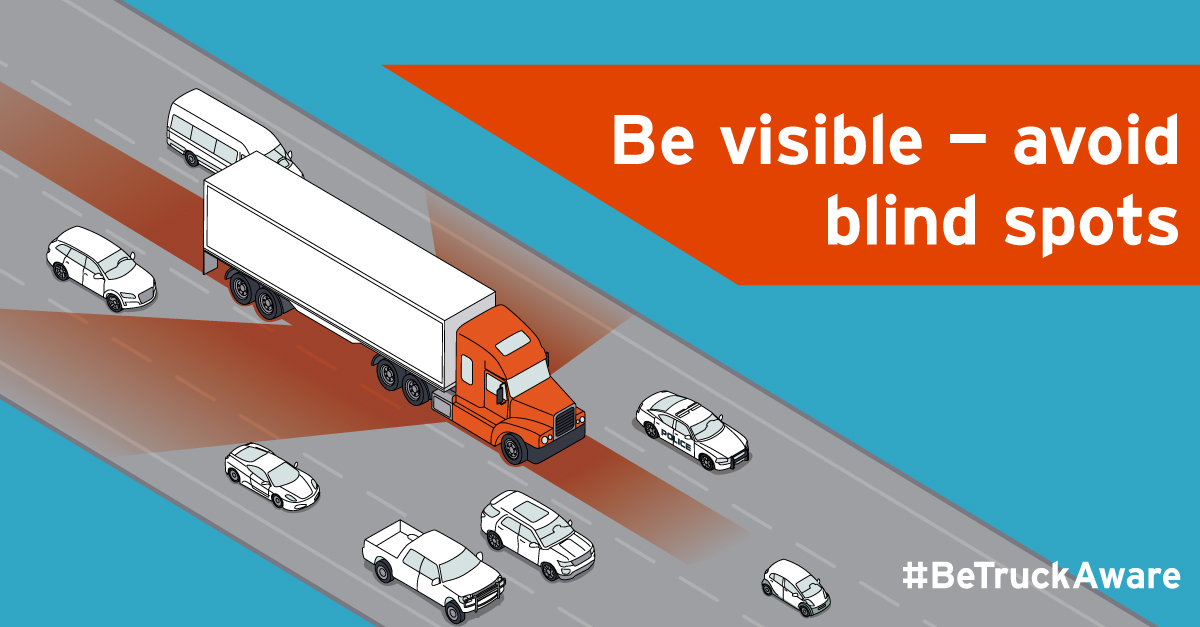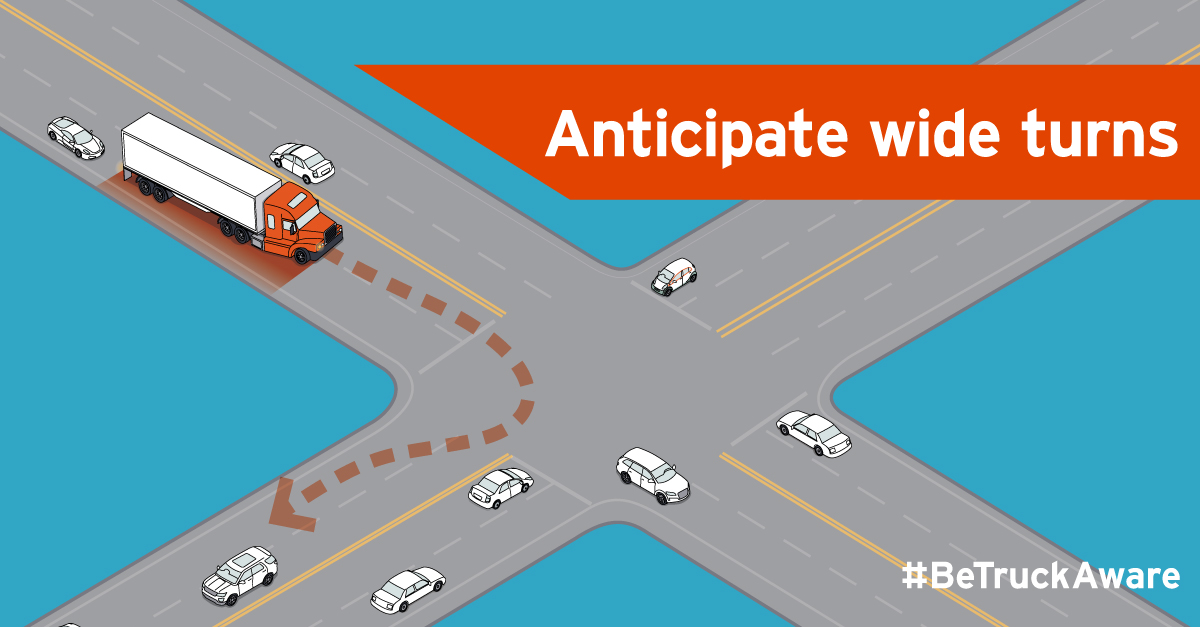
If you compare the size and weight of a loaded commercial vehicle to that of a passenger vehicle, it shouldn’t be surprising to learn the occupants of the passenger vehicle are four times more likely to be killed in a collision, according to Road Safety BC.
What may be surprising are studies showing the driver of the passenger vehicle is at fault in at least two-thirds of these incidents with trucks.
Why?
Well, the evidence suggests some drivers fail to realize large trucks perform and respond differently than smaller vehicles. Here are some examples captured by commercial vehicle dashcams. It’s important people understand that trucks need more space to turn, change lanes and stop. Trucks also have bigger blind spots.
The Be Truck Aware campaign is designed to raise awareness of truck safety in an effort to reduce the approximately 60 people killed in crashes involving commercial vehicles in BC every year.
Here are the top three ways to be truck aware, complete with video demonstrations:
1. Don’t Merge Too Soon
Commercial trucks and your car do not stop the same >> WATCH VIDEO

2. Be Visible – Avoid Blind Spots
Do not get in a commercial vehicle’s blind spot >> WATCH VIDEO

3. Anticipate Wide Turns
Why you need to give commercial vehicles room to turn >> WATCH VIDEO

Do you have any other tips for driving around large trucks, whether from the perspective of a truck driver or a passenger vehicle driver? Let us know in the comments section.
Don’t slow down and check the lug nuts while safely passing a truck in a passing lane. A tire blowout when a car is beside the truck can be very dangerous. Move along so others can pass safely.
speed up when merging onto the highway. people expect you to slow down/stop so they can merge
Thanks for this, Dave! Yes – merging can be a challenging situation but all motorists should work together to help the merge happen safely.
The commercial trucks don’t think twice to pull out in front of me giving me inches to slam on my brakes as they attempt to pass traffic going up a hill and has happened to me several times
Sorry to hear that, Faye. Driving safety goes both ways – passenger vehicle and commercial vehicle drivers. You can report commercial vehicle safety violations to our Commercial Vehicle Safety and Enforcement (CVSE) officers at 1-888-775-8785 (try to determine company name and plate number, if possible to do so safely).
Also, when you see a truck in town slow down and then put on 4 way flashers, they are going to be backing up, into a driveway etc for their delivery, give them room to do so.
Thanks
These video clips are VERY educational. Can we also have some video clarification rules for small and large roundabout right of way? (Not necessarily related to trucks)
Hi there M,
Thanks for the vote of approval. We have a blog all about roundabouts here: https://www.tranbc.ca/2020/07/02/how-to-safely-use-roundabouts-in-bc/
Safe travels!
What really disturbs me is that Semi’s and Large Commercial trucks are considered a nuisance and a unwanted obstacle on the road to 4 wheel vehicles.
The agressive behaviour that these same 4 wheelers display to pass dangerously these large Trucks shows that attitude. Without these large Trucks the store shelves remain empty, the goods don’t get to market and those same 4 wheelers starve and have no work places.
Showing kindness and appreciation for what they do is whats needed above all.
We agree, Ron – thanks for your message. Safe travels.
Is it so hard to understand and comprehend that av140000 lbs truck 83 ‘ long require more space to operate.??
Anticipate that the truck driver want’s to kill you, and try to make it difficult.
Is it so hard to understand and comprehend that av140000 lbs truck 83 ‘ long require more space to operate.??
Great, easy to understand graphic illustrations for those 4-wheelers (me). Thank you!
🙂 Hooray!
That’s what we like to hear. Thanks, Luis.
All great tips that I follow but please give truckers tips too: no speeding, no tail gating, no cutting off passenger vehicles, no laying on their horns behind passenger vehicles because we are doing the speed limit and they are in a hurry, etc. I would like to see better training for truck drivers and more truck and driver safety inspections from the government. Safety should be number one not money.
Hi Jean – thanks for this feedback. We are currently working with ICBC and the CVSE to implement a Mandatory Entry Level Training for Commercial Trucks as well. Here’s a link to more info on that: https://www.icbc.com/partners/driver-training/Documents/melt-curriculum-framework.pdf
Hope that this is helpful!
I totally agree my Drivers license has 2 speeding tickets in my lifetime and I have been driving for 60 years. I have observed all of the above fractions that have happened to me and other vehicles on the road by truckers stupidity . They are out to kill you
Maybe you should learn the basics rules of the road
I agree. Truck drivers need TRAINING and should follow these rules. How many these days are REQUIRED to get proper training. More and more and more transports are 2 and 3 loads- not the old 18 wheeler. And cars are getting smaller! These trucks need more ability to see car wherever they are near them.
Hi Florence,
As of October 2021, individuals applying for a BC Class 1 driver’s licence must successfully complete an ICBC-approved Class 1 MELT course before attempting a road test. BC’s MELT program was developed through a review of best practices from other Canadian jurisdictions and with input from industry in BC. It was designed to align with the Standard 16-Class 1 Entry-Level Training framework introduced as part of the National Safety Code in February 2020.
I second this request please. I am a cautious, older driver of a 1993 car, and I also would like to see big trucks (and people speeding in passenger vehicles) giving me more space! It frightens me when they come too close, or honk their horns–causing panic and danger. PLEASE GIVE SLOW CARS MORE SPACE AND CONSIDERATION. WE NEED TO DRIVE WITHIN OUR CAPABILITY FOR ALL OF US TO BE SAFE.
When we roll slowly to a stp light it’s an attempt to keep our momentum so we don’t slow you. PLEASE leave any space in front of me empty. Shooting out of your lane and into mine and braking is bound to have tragic consequences.
Merge by definition means find your spot and match speed and smoothly enter traffic flow. If I don’t move it means I cannot…please adjust your speed as your fuel pedal reacts much more quickly than mine.
DON’T CUT ME OFF!!!it’s not only terribly dangerous but it’s downright rude.
And as for the roundabout…don’t race that big truck into the intersection. Vehicles cornering like that are impossible to estimate speedwise. Be safe and just let the driver make his way safely through. Down east, cars aren’t even allowed in the roundabout when a truck is in it. Much safer for all.
Let’s make our roads safe for all of us.
Thanks for letting me rant, enjoy your day.
Thanks for taking the time to share your concerns with us Patricia! We appreciate it. Safe travels.
I could write a book as the vast majority of drivers have no clue around semi’s, Your video says don’t pull in front until you can see both headlights, but in REALITY you shouldn’t pull in front until 5 seconds ahead of a semi in Ideal conditions. I get 4 wheelers cut in front of me all day long as soon as they’re past, and one reason I have dash cams, to show the judge it was suicide should something happen.
Thanks for your comments Larry!
I want to say how important this information is and I personally appreciate these tips being spread. I am in the towing industry and respond to emergency calls. Some of us tow truck drivers take to engaging in conversations like this as a form of therapy. A colleague of mine just last week responded to an accident involving a vehicle and a semi truck. Similar to the first scenario described above, the vehicle merged early, was forced to brake and the semi truck could not stop in time to avoid collision. The incident was horrific, the be truck aware campaign is something that hits home for us.
With the winter season we had in the lower mainland, we would also like to remind that we must be even more diligent around commercial vehicle in varying weather conditions. AtCoquitlam Towing we responded to many incidents of this nature and want to see them reduced. Its campaigns like this that will help us get there. Another tip would be to be on high alert of commercial vehicles with their hazards on. Sometimes people attempt to pass on the shoulder or go around the truck when it is slow. But people need to be more mindful and patient as they often get caught. More often then not when we arrive on the scene ourTowing Services are not what you need the most, but an ambulance.
Thank-you for spreading awareness and we hope these tips add value to all.
And thank you for sharing your thoughts, Trent. It’s valuable to have input here from those with direct experience.
Do not enter a roundabout beside a truck. You would not believe how many cars have done that to me.
A great tip – thank you. Best to give rigs plenty of room to maneuver in a roundabout – they need as much as they can get.
I have seen them dump their loads in a round about with no other vehicles near by
All consideration to some comments, there’s plenty of fault on all sides for poor driving habits. A lot of car drivers are oblivious to how a truck handles/drives/stops. A lot of truck drivers are either poorly trained/supervised, or they are taking unnecessary risks due to poor pay or questionable dispatch practices.
3 words
Common Sense
Respect
Apply those, and many driving problems go away.
Trucks handle differently in adverse weather than cars. Were less likely to hydroplane (assuming decent tires), inertia is generally our friend in corners and hills, so long as we’re within our safe-for-conditions speed…sometimes too slow is worse, especially in bad traction conditions. Be aware of your surroundings and the conditions, apply Common Sense and Respect in healthy doses and plan ahead.
Truckers can have difficulty seeing when it’s safe to pull back into the right lane after passing you,
especially with long rigs, at night, and in conditions of restricted visibility, like rain, fog, snow, hail,
or with the rising or setting sun glaring in their side mirrors.
You can help them, once the end of their rig is a safe distance past you, by BRIEFLY flashing your
high beams to let them know it is safe to pull in front of you.
Most commercial drivers, especially the long truck and trailer drivers will show their appreciation by
flashing their right side reversing light. Give yourself a pat on the back!
Just remember, the closer you are to any vehicle, particularly a big truck, the faster accidents can
happen.
A truck tire delaminating can come through your windshield. Imagine what I could do to you if you are riding
a motorcycle!
So, be prepared to take evasive action with virtually no warning.
Safe and Happy Trails.
Ramblin’ Ryan Lake.
Hi Ryan and thank you so much for sharing this important tip with us. Safe travels!
While travelling from Abbotsford to Burnaby in challenging driving conditions due to very heavy rain last eve from about 5 to 6:30 p.m. I was again literally dumfounded by the speed at which semis were driving in the ‘fast lane’ to my left. I am currently driving an Acura sedan and am fully aware of the impact I will incur should a semi hit me. I deliberately stayed out of the left/’fast’ lane and drove for the conditions as is a consideration when I am driving. I am aware some car drivers do not consider driving conditions when they are driving and drive in ways that can result in accidents, e.g. /making lane changes/cutting in front of other cars, not just trucks, when it is not safe to do so.
I travel up and down and across the width of Vancouver Island for my work, travel to Abbotsford on the way to our ‘getaway and so many other routes. I know some people drive unsafely and some of those people are driving semis. Again, hitting those of us driving cars will lead to us incurring greater injury. This past October 18 my husband drove me, in his SAAB sedan, from our home in Burnaby to a ‘rush’ biopsy at Abbotsford Regional Hospital. The rain was torrential on that day. At one point he commented he was driving behind the semi in front of us as he had observed his driving behaviour to be responsible. He followed far enough back from that semi that he would be able to top if stopping was indicated. As happened last eve, and as happens too often when I am driving, semis were literally blowing past us in both the left/’fast’ lane and in the lane to our right when there was such a lane. On October 18 I was shocked at the tractors pulling trailer that pulled into the distance my husband was deliberately leaving behind the semi as he was remaining cognizant of longer stop times due to the heavy rain. My husband drove semis for years. He, e.g. moved concrete bridge components from the Lower Mainland to other parts of BC and drove the steer dolly while working to transport concrete beams from Richmond to sites along the Expo line as it was being built. We traveled across Canada and back to Burnaby via the US with my husband driving our 5th wheel. Through travelling with him and what he has shared with myself and our now adult children I know my husband is a safe driver. Is there a way to raise safety consciousness among more of those driving semis, i.e. the 1/3 who are at fault when they hit a passenger vehicle in which there is a resulting fatality. I am mindful of the impact a semi will cause if one hits my car and do my best to keep my distance from those I see driven unsafely and including at excessive speeds as I do passenger vehicles driven unsafely and including at excessive speeds.
Hello Dianne and thank you for your very thoughtful comment! Having conversations like this, on a public forum, is the first step in raising awareness on this topic. Careful and cautious drivers such as yourself and your husband, driving responsibly and setting a good example for others is also a good step. We will also share this feedback with the Commercial Vehicle Safety Enforcement group for discussion as well. Thanks again and safe travels.
Don’t stay anywhere next to them, and in particular try to ensure you are not on the outside of a transport in a curve. If anything were to happen, that high centered vehicle or trailer will go out, right on top of you. This is most important for loaded logging trucks and concrete trucks.
Thanks for your comment Bart. Giving commercial drivers as much space as possible is always a wise idea.